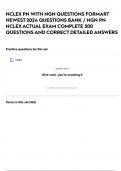NCLEX PN WITH NGN QUESTIONS FORMART
NEWEST 2024 QUESTIONS BANK / NGN PN
NCLEX ACTUAL EXAM COMPLETE 500
QUESTIONS AND CORRECT DETAILED ANSWERS
Practice questions for this set
Learn
Studied 7 terms
Nice work, you're crushing it
Continue studying in Learn
Terms in this set (104)
, Traumatic burn
A nurse reviews a client's
electrolyte results and
notes a potassium level of Rationale:
5.5 mEq/L. The nurse A serum potassium level that exceeds 5.1 mEq/L is
understands that a indicative of hyperkalemia. Clients who experience
potassium value at this the cellular shifting of potassium, as in the early
level would be noted with stages of massive cell destruction (i.e., with trauma,
which condition burns, sepsis, or metabolic or respiratory acidosis), are
at risk for hyperkalemia. The client with Cushing's
syndrome or diarrhea and the client who has been
overusing laxatives are at risk for hypokalemia.
A nurse reviews a client's Narrow, peaked T waves
electrolyte results and Rationale:
notes that the potassium A serum potassium level of 5.4 mEq/L is indicative of
level is 5.4 mEq/L. Which hyperkalemia. Cardiac changes include a wide, flat P
of the following would the wave; a prolonged PR interval; a widened QRS
nurse note on the cardiac complex; narrow, peaked T waves; and a depressed ST
monitor as a result of this segment.
laboratory value?
The client with diabetes mellitus
Fluid that shifts into the interstitial spaces and remains
A nurse is reviewing the
there is referred to as third-space fluid. Common sites
health records of assigned
for third-spacing include the abdomen, pleural cavity,
clients. The nurse plans
peritoneal cavity, and pericardial sac. Third-space
care knowing that which
fluid is physiologically useless because it does not
client is at the lowest risk
circulate to provide nutrients for the cells. Risk factors
for the development of
include liver or kidney disease, major trauma, burns,
third-spacing?
sepsis, wound healing, major surgery, malignancy,
malabsorption syndrome, malnutrition, alcoholism,
and older age.
, The client with a colostomy
A nurse is reviewing the
Rationale:
health records of assigned
Causes of a fluid volume deficit include vomiting,
clients. The nurse plans
diarrhea, conditions that cause increased respirations
care knowing that which
or increased urinary output, insufficient intravenous
client is at risk for fluid
fluid replacement, draining fistulas, ileostomy, and
volume deficit?
colostomy. A client with cirrhosis, CHF, or decreased
kidney function is at risk for fluid volume excess.
The client with the syndrome of inappropriate
A nurse reviews
secretion of antidiuretic hormone (SIADH)
electrolyte values and
notes a sodium level of
Rationale:
130 mEq/L. The nurse
Hyponatremia is a serum sodium level less than 135
understands that this
mEq/L. Hyponatremia can result secondary to SIADH.
sodium level would be
The client with an inadequate daily water intake,
noted in a client with
watery diarrhea, or diabetes insipidus is at risk for
which condition?
hypernatremia.
A nurse is caring for a Postural blood pressure changes
client with leukemia and
notes that the client has Rationale:
poor skin turgor and flat Postural blood pressure changes occur in the client
neck and hand veins. The with hyponatremia. Dry mucous membranes and
nurse suspects intense thirst are seen in clients with hypernatremia. A
hyponatremia. What slow, bounding pulse is not indicative of
additional signs would the hyponatremia. In a client with hyponatremia, a rapid
nurse expect to note in thready pulse is noted.
this client if hyponatremia
is present?
, A nurse is caring for a Generalized muscle weakness
client with a suspected Rationale:
diagnosis of Generalized muscle weakness is seen in clients with
hypercalcemia. Which of hypercalcemia. Options 1,twitching 2, Positive
the following signs would Trousseau's sign and 3 Hyperactive bowel sounds
be an indication of this identify signs of hypocalcemia.
diagnosis
Calcitonin (Miacalcin)
A nurse is caring for a
Rationale:
client with
The normal serum calcium level is 8.6 to 10.0 mg/dL.
hyperparathyroidism and
This client is experiencing hypercalcemia. Calcium
notes that the client's
gluconate and calcium chloride are medications used
serum calcium level is 13
for the treatment of tetany, which occurs as a result of
mg/dL. Which medication
acute hypocalcemia. In hypercalcemia, large doses of
should the nurse prepare
vitamin D need to be avoided. Calcitonin, a thyroid
to administer as
hormone, decreases the plasma calcium level by
prescribed to the client?
inhibiting bone resorption and lowering the serum
calcium concentration.
Encourage the client to slow down breathing
Rationale:
The client is in respiratory alkalosis based on the
A client has the following
laboratory results of a high pH and a low Pco2 level.
laboratory values: a pH of
Interventions for respiratory alkalosis are the voluntary
7.55, an HCO level of 22
holding of breath or slowed breathing and the
mm Hg, and a Pco2 of 30
rebreathing of exhaled CO2 by methods such as using
mm Hg. What should the
a paper bag or a rebreathing mask as prescribed.
nurse do?
Option 1 would be incorrect, because the blood
specimen has already been drawn, and the laboratory
results have been completed. Options 2 and 3 are
interventions for metabolic acidosis.




